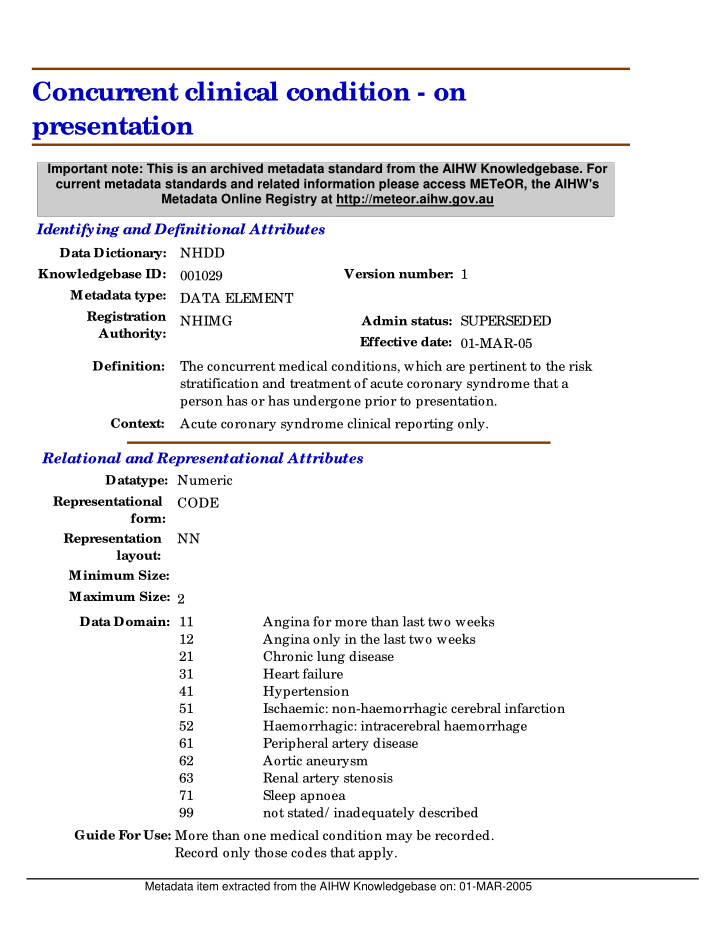



Concurrent clinical condition - on presentation Important note: This is an archived metadata standard from the AIHW Knowledgebase. For current metadata standards and related information please access METeOR, the AIHW's Metadata Online Registry at http://meteor.aihw.gov.au Identifying and Definitional Attributes Data Dictionary: NHDD Knowledgebase ID: Version number: 1 001029 Metadata type: DATA ELEMENT Registration NHIMG Admin status: SUPERSEDED Authority: Effective date: 01-MAR-05 Definition: The concurrent medical conditions, which are pertinent to the risk stratification and treatment of acute coronary syndrome that a person has or has undergone prior to presentation. Context: Acute coronary syndrome clinical reporting only. Relational and Representational Attributes Datatype: Numeric Representational CODE form: Representation NN layout: Minimum Size: Maximum Size: 2 11 Angina for more than last two weeks Data Domain: 12 Angina only in the last two weeks 21 Chronic lung disease 31 Heart failure 41 Hypertension 51 Ischaemic: non-haemorrhagic cerebral infarction 52 Haemorrhagic: intracerebral haemorrhage 61 Peripheral artery disease 62 Aortic aneurysm 63 Renal artery stenosis 71 Sleep apnoea 99 not stated/ inadequately described Guide For Use: More than one medical condition may be recorded.� Record only those codes that apply.� Metadata item extracted from the AIHW Knowledgebase on: 01-MAR-2005
Record all codes that apply.� Codes 21, 31, 51, 52, 61, 62, 63, and 71 must be accompanied by a Clinical evidence status code.� � Acute coronary syndrome - DSS specific:� Angina� Code 11 - This code is used where there are symptoms, which can be described as chest pain or pressure, jaw pain, arm pain, or other equivalent discomfort suggestive of cardiac ischaemia, for more than the last two weeks.� Code 12 - This code is used where there are symptoms, which can be described as chest pain or pressure, jaw pain, arm pain, or other equivalent discomfort suggestive of cardiac ischaemia, only in the last two weeks.� � Chronic lung disease � Code 21 -This code is used where there is a history or symptoms suggestive of chronic lung disease.� � Heart failure � Code 31 -This code is used where a patient has past or current symptoms of heart failure (typically breathlessness or fatigue), either at rest or during exercise and/ or signs of pulmonary or peripheral congestion suggestive of cardiac dysfunction.� � Hypertension� Code 41 - This code is used where there is current use of pharmacotherapy for hypertension and/ or clinical evidence of high blood pressure.� � Stroke � Code 51 - This code is used if there is history of stroke or cerebrovascular accident (CVA) resulting from an ischaemic event where the patient suffered a loss of neurological function with residual symptoms remaining for at least 24 hours.� Code 52 - This code is used if there is history of stroke or cerebrovascular accident (CVA) resulting from a haemorrhagic event where the patient suffered a loss of neurological function with residual symptoms remaining for at least 24 hours.� � Peripheral arterial disease � Code 61 - This code is used where there is history of either chronic or acute occlusion or narrowing of the arterial lumen in the aorta or extremities.� Code 62 - This code is used where there is a history of aneurysmal Metadata item extracted from the AIHW Knowledgebase on: 01-MAR-2005
dilatation of the aorta (thoracic and or abdominal).� Code 63 - This code is used where there is history of functional stenosis of one or both renal arteries.� � Sleep Apnoea syndrome � Code 71 - This code is used where there is evidence of sleep apnoea syndrome (SAS) on history. Related metadata: is qualified by Clinical evidence status version 1 is used in conjunction with Fibrinolytic therapy status version 1 Administrative Attributes Source Document: Source Organisation: Acute Coronary Syndrome Data Working Group. Data Element Links Information Model Entities linked to this Data Element NHIM Physical wellbeing Data Agreements which include this Data Element DSS - Acute coronary syndrome (clinical) From 04-J un-04 to Metadata item extracted from the AIHW Knowledgebase on: 01-MAR-2005
Recommend
More recommend